DELAFIELD, Wis. (Stockpickr) -- Trading stocks that trigger major breakouts can lead to massive profits. Once a stock trends to a new high, or takes out a prior overhead resistance point, then it's free to find new buyers and momentum players that can ultimately push the stock significantly higher.
One example of a successful breakout trade I flagged recently was biopharmaceutical player Idenix Pharmaceuticals (IDIX), which I featured in July 18's "5 Stocks Under $10 Set to Soar" at around $3.60 a share. I mentioned in that piece that shares of IDIX had recently gapped down sharply from $5.25 to $3.35 a share with heavy downside volume. Shares of IDIX went on to hit a low of $3.15 a share, but I was noticing that the stock was starting to rebound off that low and moving within range of triggering a major breakout trade. That trade was set to trigger if IDIX managed to take out some near-term overhead resistance at $3.72 a share and then once it cleared its gap down day high at $3.75 a share with strong volume.
Guess what happened? Shares of IDIX didn't wait long to trigger that move, since the stock started to break out on July 30 with strong upside volume flows. This stock continued to boom to the upside after breaking out, with shares hitting an intraday high on Thursday of $4.69 a share. That represents a gain of well over 30% since the time of my original article. You can see here how powerful breakout trading can be once key resistance levels are taken out with volume. I don't think this stock is done going up and it has a great chance to re-fill the rest of its gap back towards $5.20 to $5.50 a share in the near future.
Breakout candidates are something that I tweet about on a daily basis. I frequently tweet out high-probability setups, breakout plays and stocks that are acting technically bullish. These are the stocks that often go on to make monster moves to the upside. What's great about breakout trading is that you focus on trend, price and volume. You don't have to concern yourself with anything else. The charts do all the talking.
Trading breakouts is not a new game on Wall Street. This strategy has been mastered by legendary traders such as William O'Neal, Stan Weinstein and Nicolas Darvas. These pros know that once a stock starts to break out above past resistance levels, and hold above those breakout prices, then it can easily trend significantly higher.
With that in mind, here's a look at five stocks that are setting up to break out and trade higher from current levels.
Walter Energy
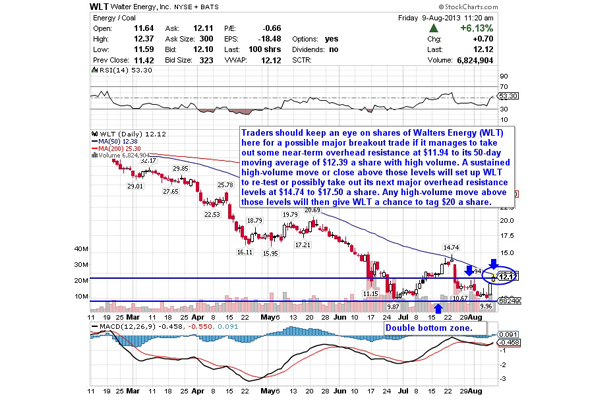
One name that's quickly pushing within range of triggering a major breakout trade is Walter Energy (WLT), which is a producer and exporter of metallurgical coal for the global steel industry. This stock has been rocked by the shorts so far in 2013, with shares off sharply by 66%.
If you take a look at the chart for Walter Energy, you'll notice that this stock has been downtrending badly for the last six months, with shares plunging from over $40 to its recent low of $9.87 a share. During that downtrend, shares of WLT have been consistently making lower highs and lower lows, which is bearish technical price action. That said, shares of WLT have now formed a double bottom over the last month, with shares finding buying interest as $9.87 and then at $9.96. This stock has started to rebound higher off that double bottom area, and it's now quickly moving within range of triggering a major breakout trade.
Traders should now look for long-biased trades in WLT if it manages to break out above some near-term overhead resistance at $11.94 to its 50-day moving average of $12.39 a share with high volume. Look for a sustained move or close above those levels with volume that hits near or above its three-month average volume of 9.32 million shares. If that breakout hits soon, then WLT will set up to re-test or possibly take out its next major overhead resistance levels at $14.74 to $17.50 a share. Any high-volume move above those levels will then give WLT a chance to tag $20 a share.
Traders can look to buy WLT off any weakness to anticipate that breakout and simply use a stop that sits right below today's low of $11.59 a share, or right below $11 a share. If we get weakness below those levels, then I would key off of those double bottom levels at $9.96 to $9.87 a share. One could also buy WLT off strength once it takes out those breakout levels with volume and then simply use a stop that sits a comfortable percentage from your entry point.
This stock is loved by the bears, since the current short interest as a percentage of the float for WLT is ridiculously high at 40.7%. The bears have also been increasing their bets from the last reporting period by 4.6%, or by about 1.10 million shares. If that breakout hits soon, then WLT could see a big short-squeeze, so make sure to have this name on your breakout trading radar.
U.S. Steel
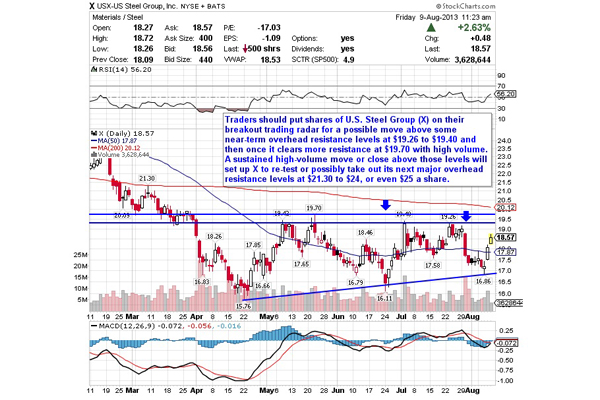
Another stock that looks poised to trigger a big breakout trade is U.S. Steel (X), which is an integrated steel producer of flat-rolled and tubular products with major production operations in North America and Europe. This stock has been hit hard by the sellers so far in 2013, with shares off by 22%.
If you take a look at the chart for U.S. Steel, you'll notice that this stock has been trending sideways and consolidating for the last three months and change, with shares moving between $15.76 on the downside and $19.70 on the upside. Shares of X have just started to trend back above its 50-day moving average of $17.87 a share and it's quickly pushing within range of triggering a big breakout trade above the upper-end of its sideways trading chart pattern. If this breakout hits soon, then it would take X out of its consolidation pattern and potentially into a new uptrend.
Traders should now look for long-biased trades in X if it manages to break out above some near-term overhead resistance levels at $19.26 to $19.40 and then once it clears more resistance at $19.70 with high volume. Look for a sustained move or close above those levels with volume that hits near or above its three-month average action 7.31 million shares. If that breakout triggers soon, then X will set up to re-test or possibly take out its next major overhead resistance levels at $21.30 to $24, or even $25 a share.
Traders can look to buy X off any weakness to anticipate that breakout and simply use a stop that sits right below its 50-day at $17.87 a share, or below more support at $16.86 a share. One could also buy X off strength once it takes out those breakout levels with volume and then simply use a stop that sits a comfortable percentage from your entry point.
This stock is another favorite target of the short-sellers, since the current short interest as a percentage of the float for X is very high at 30.1%. This stock could easily see a powerful short-squeeze if that breakout hits soon, so make sure to keep it on watch.
AthenaHealth
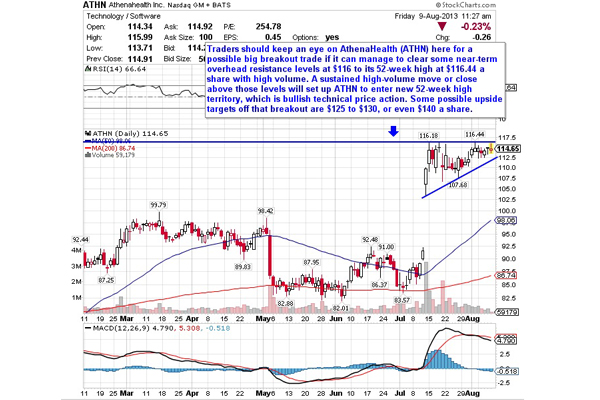
One name that's starting to trend within range of triggering a near-term breakout trade is AthenaHealth (ATHN), which is a provider of Internet-based business services for physician practices. This stock has been on fire so far in 2013, with shares up sharply by 57.4%.
If you look at the chart for AthenaHealth, you'll notice that this stock recently gapped up sharply from $92.50 to its high of $116.18 a share with heavy upside volume. Following that gap, shares of ATHN pulled back to a low of $107.68 a share, before entering a consolidation pattern between $112.50 and its new 52-week high at $116.44 a share. This stock now looks ready to trigger a breakout trade and take out the upper-end of its consolidation chart pattern.
Traders should now look for long-biased trades in ATHN if it manages to break out above some near-term overhead resistance levels at $116 to its 52-week high at $116.44 a share with high volume. Look for a sustained move or close above those levels with volume that hits near or above its three-month average action of 500,969 shares. If that breakout triggers soon, then ATHN will set up to enter new 52-week-high territory, which is bullish technical price action. Some possible upside targets off that breakout are $125 to $130, or even $140 a share.
Traders can look to buy ATHN off any weakness to anticipate that breakout and simply use a stop that sits right below some near-term support at $112.50 a share, or down near more support at $110 a share. One can also buy ATHN off strength once it takes out those breakout levels with volume and then simply use a stop that sits a comfortable percentage from your entry point.
This is another name that is very popular among the bears, since the current short interest as a percentage of the float for ATHN is extremely high at 23.9%. If that breakout triggers soon, then ATHN could explode higher, so make sure to keep this name on watch.
Western Refining
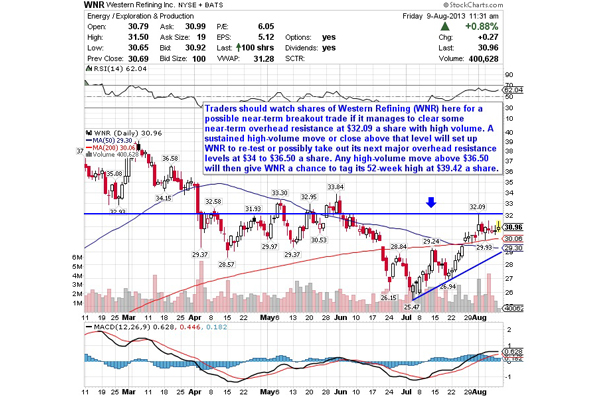
Another stock that's starting to trend within range of triggering a near-term breakout trade is Western Refining (WNR), a crude oil refiner and marketer of refined products. It also operates service stations and convenience stores. This stock is off to a decent start in 2013, with shares up 10.8%.
If you look at the chart for Western Refining, you'll notice that this stock has been uptrending strong for the last month and change, with shares soaring higher from its low of $25.47 to its recent high of $32.09 a share. During that uptrend, shares of WNR have been consistently making higher lows and higher highs, which is bullish technical price action. This stock has also moved back above both its 50-day and 200-day moving averages, which is bullish. That move has now pushed shares of WNR within range of triggering a near-term breakout trade.
Traders should now look for long-biased trades in WNR if it manages to break out above some near-term overhead resistance at $32.09 a share with high volume. Look for a sustained move or close above that level with volume that hits near or above its three-month average action of 1.96 million shares. If that breakout triggers soon, then WNR will set up to re-test or possibly take out its next major overhead resistance levels at $34 to $36.50 a share. Any high-volume move above $36.50 will then give WNR a chance to tag its 52-week high at $39.42 a share.
Traders can look to buy WNR off any weakness to anticipate that breakout and simply use a stop that sits right below either its 200-day at $30.06 a share or its 50-day at $29.30 a share. One can also buy WNR off strength once it takes out that breakout level with volume and then simply use a stop that sits a comfortable percentage from your entry point.
This is yet again another name that the bears are in love with, since the current short interest as a percentage of the float for WNR is crazy high at 39.7%. A monster short-squeeze could easily trigger here if that breakout hits soon, so make sure to put this name on your trading radar.
Himax Technologies
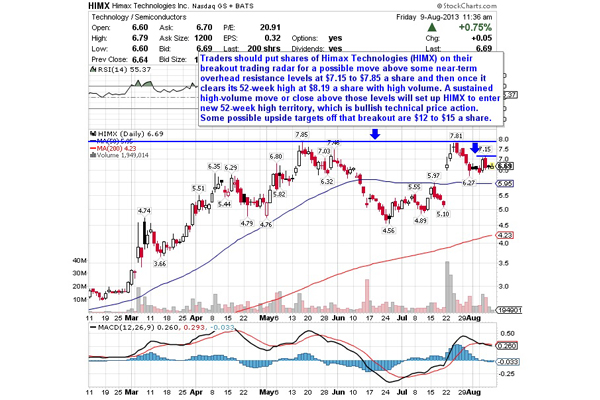
My final breakout trading prospect is Himax Technologies (HIMX), which designs, develops and markets semiconductors that are critical components of flat panel displays. This stock has been a monster mover to the upside so far in 2013, with shares up a whopping 181%.
If you look at the chart for Himax Technologies, you'll notice that this stock has been uptrending strong over the last two months, with shares moving higher from its low of $4.56 to its recent high of $7.81 a share. During that move, shares of HIMX have been consistently making higher lows and higher highs, which is bullish technical price action. Over the last two week, shares of HIMX have come out of its uptrend and simply started to consolidate its gains between $6.27 on the downside and $7.15 on the upside. A high-volume move above the upper-end of its recent range could now trigger a big breakout trade for HIMX.
Traders should now look for long-biased trades in HIMX if it manages to break out above some near-term overhead resistance levels at $7.15 to $7.85 a share and then once it clears its 52-week high at $8.19 a share with high volume. Look for a sustained move or close above those levels with volume that hits near or above its three-month average action of 6.30 million shares. If that breakout triggers soon, then HIMX will set up to enter new 52-week high territory, which is bullish technical price action. Some possible upside targets off that breakout are $12 to $15 a share.
Traders can look to buy HIMX off any weakness to anticipate that breakout and simply use a stop that sits right below its 50-day moving average of $5.95 a share. One could also buy HIMX off strength once it clears those breakout levels with volume and then simply use a stop that sits a conformable percentage from your entry point.
To see more breakout candidates, check out the Breakout Stocks of the Week portfolio on Stockpickr.
-- Written by Roberto Pedone in Delafield, Wis.
 “This brings a whole new dynamic to the broker-dealer world,” said Jonathan Henschen (right), president of the recruiting firm Henschen & Associates, in an interview with AdvisorOne. “It’s like in the ’80s when insurance firms were buying broker-dealers, but now maybe its real-estate conglomerates flush with money that will be buying BDs.”
“This brings a whole new dynamic to the broker-dealer world,” said Jonathan Henschen (right), president of the recruiting firm Henschen & Associates, in an interview with AdvisorOne. “It’s like in the ’80s when insurance firms were buying broker-dealers, but now maybe its real-estate conglomerates flush with money that will be buying BDs.” "Lovell Minnick was a great owner for First Allied," said Chip Roame (right), managing principal of Tiburon Strategic Advisors, in an interview. "First Allied, with Lovell Minnick capital, was able to make several tuck-in acquisitions and also expand through the acquisition of clearing firm Legend ... RCAP in some ways is just a new capital partner, replacing Lovell Minnick."
"Lovell Minnick was a great owner for First Allied," said Chip Roame (right), managing principal of Tiburon Strategic Advisors, in an interview. "First Allied, with Lovell Minnick capital, was able to make several tuck-in acquisitions and also expand through the acquisition of clearing firm Legend ... RCAP in some ways is just a new capital partner, replacing Lovell Minnick." Richard Drew/AP Bank of America Merrill Lynch equity strategist Savita Subramanian is bullish on the stock market. Recently, she hiked her S&P 500 year-end price target to 1,750 from 1,600, one of the most optimistic forecasts on Wall Street. (The index closed Thursday at 1,697, so Subramanian's target implies an additional 3.1 percent upside through the rest of 2013.) "With the S&P 500 rising over 20 percent over the past twelve months and continuing to make all-time highs, the pervasive refrain is that the market has grown expensive," writes Subramanian in a note to clients. "Admittedly, the majority of 2013's gains have come from multiple expansion rather than earnings growth, but the market is far from overvalued. This suggests that the market has merely played catch up with fundamentals -- recall that earnings made new highs in 2010. Valuation remains a driver for our bullish view on stocks." The table below shows 15 popular S&P 500 valuation metrics:
Richard Drew/AP Bank of America Merrill Lynch equity strategist Savita Subramanian is bullish on the stock market. Recently, she hiked her S&P 500 year-end price target to 1,750 from 1,600, one of the most optimistic forecasts on Wall Street. (The index closed Thursday at 1,697, so Subramanian's target implies an additional 3.1 percent upside through the rest of 2013.) "With the S&P 500 rising over 20 percent over the past twelve months and continuing to make all-time highs, the pervasive refrain is that the market has grown expensive," writes Subramanian in a note to clients. "Admittedly, the majority of 2013's gains have come from multiple expansion rather than earnings growth, but the market is far from overvalued. This suggests that the market has merely played catch up with fundamentals -- recall that earnings made new highs in 2010. Valuation remains a driver for our bullish view on stocks." The table below shows 15 popular S&P 500 valuation metrics:  BofA Merrill Lynch US Equity & US Quant Strategy "The majority indicate that the market is still trading below or in-line with historical norms, suggesting that the rally has chiefly been driven by a recovery in multiples from very depressed levels," says Subramanian. The one metric of the 15 that says stocks are expensive is the Shiller price/earnings ratio: The Shiller P/E, which is based on inflation-adjusted earnings over the past 10 years, currently suggests that stocks are overvalued. However, this metric assumes that the normalized (cyclically adjusted) EPS for the S&P 500 is today less than $70 -- well below even our recessionary scenario for EPS. The methodology assumes that the last 10 years is a representative sample, but the most recent profits recession was the worst we have seen and was exacerbated by a high leverage ratio which has since been dramatically reduced. Assuming that this scenario is going to repeat itself is, we think, overly pessimistic. Subramanian argues that if stocks are expensive, "other asset classes are really expensive." "While the relative attractiveness of stocks versus bonds, as measured by the equity risk premium (ERP), has moderated from all-time highs, the ERP still remains well above historical norms," writes the BAML strategist. "And compared to commodities, stocks are sill attractive -- the price of the S&P 500 in WTI oil terms is currently 16 [oil barrels], vs. the historical average of 22 [oil barrels]. Similarly, the S&P is trading at 1.3x the price of a Troy oz. of gold, while it has historically traded at 1.5x." That's not to say some stocks aren't expensive. Subramanian flags the consumer discretionary sector as overvalued versus historical norms, along with "the more defensive, high-yielding, domestically-focused stocks within Telecom and Utilities."
BofA Merrill Lynch US Equity & US Quant Strategy "The majority indicate that the market is still trading below or in-line with historical norms, suggesting that the rally has chiefly been driven by a recovery in multiples from very depressed levels," says Subramanian. The one metric of the 15 that says stocks are expensive is the Shiller price/earnings ratio: The Shiller P/E, which is based on inflation-adjusted earnings over the past 10 years, currently suggests that stocks are overvalued. However, this metric assumes that the normalized (cyclically adjusted) EPS for the S&P 500 is today less than $70 -- well below even our recessionary scenario for EPS. The methodology assumes that the last 10 years is a representative sample, but the most recent profits recession was the worst we have seen and was exacerbated by a high leverage ratio which has since been dramatically reduced. Assuming that this scenario is going to repeat itself is, we think, overly pessimistic. Subramanian argues that if stocks are expensive, "other asset classes are really expensive." "While the relative attractiveness of stocks versus bonds, as measured by the equity risk premium (ERP), has moderated from all-time highs, the ERP still remains well above historical norms," writes the BAML strategist. "And compared to commodities, stocks are sill attractive -- the price of the S&P 500 in WTI oil terms is currently 16 [oil barrels], vs. the historical average of 22 [oil barrels]. Similarly, the S&P is trading at 1.3x the price of a Troy oz. of gold, while it has historically traded at 1.5x." That's not to say some stocks aren't expensive. Subramanian flags the consumer discretionary sector as overvalued versus historical norms, along with "the more defensive, high-yielding, domestically-focused stocks within Telecom and Utilities."





